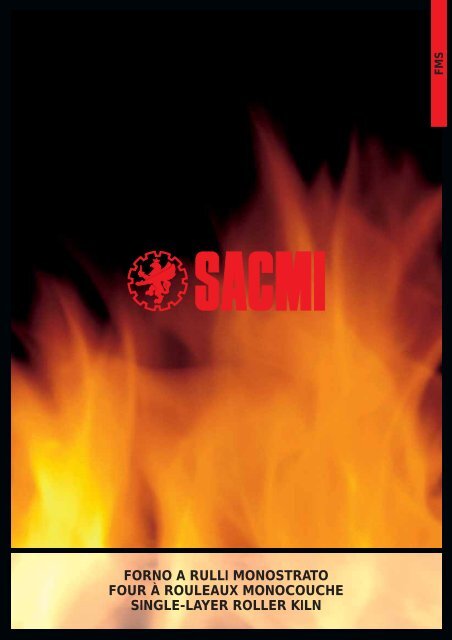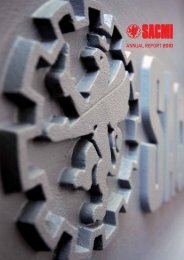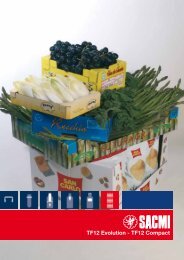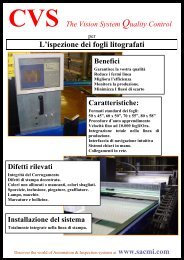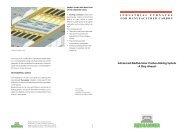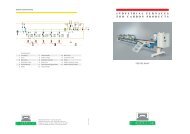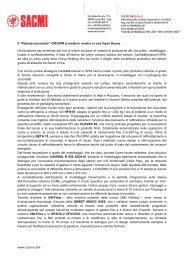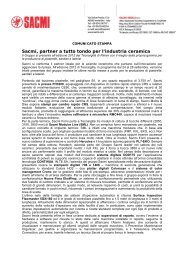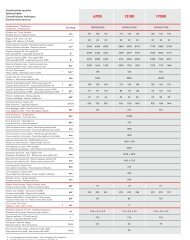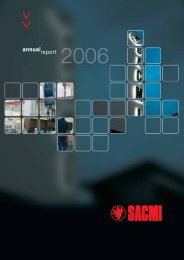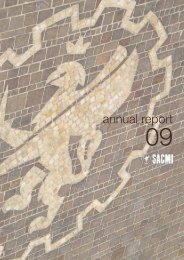FMS - Sacmi Forni
FMS - Sacmi Forni
FMS - Sacmi Forni
Create successful ePaper yourself
Turn your PDF publications into a flip-book with our unique Google optimized e-Paper software.
FORNO A RULLI MONOSTRATO<br />
FOUR À ROULEAUX MONOCOUCHE<br />
SINGLE-LAYER ROLLER KILN<br />
<strong>FMS</strong>
<strong>FMS</strong><br />
Ci sarà<br />
un perché<br />
Il doit bien y<br />
avoir une raison<br />
There are<br />
reasons why<br />
Il forno monostrato a rulli<br />
<strong>FMS</strong> è:<br />
economico,<br />
perché ben isolato, facile<br />
da trasportare e da montare,<br />
preciso nelle regolazioni;<br />
flessibile,<br />
perché i bruciatori oltre ad<br />
essere numerosi sono versatili<br />
e perché i controlli sono<br />
puntuali;<br />
produttivo,<br />
perché i consumi<br />
sono ottimizzati;<br />
di qualità,<br />
perché le curve di cottura<br />
sono precise, la motorizzazione<br />
è affidabile e la distribuzione<br />
del calore è omogenea;<br />
sicuro,<br />
perché conforme<br />
alle normative CEN EN 746-1<br />
e CEN EN 746-2.
<strong>FMS</strong><br />
Le four à rouleaux<br />
monocouche <strong>FMS</strong> est:<br />
économique,<br />
parce qu’il est bien isolé, facile<br />
à transporter et à monter, et qu’il<br />
assure des réglages précis;<br />
flexible,<br />
parce que les brûleurs sont<br />
non seulement nombreux mais<br />
aussi polyvalents, et que les<br />
contrôles<br />
sont précis et constants;<br />
productif,<br />
parce que les consommations<br />
sont optimisées;<br />
de qualité,<br />
parce que les courbes de<br />
cuisson sont précises, le moteur<br />
est fiable et que la distribution<br />
de la chaleur est homogène;<br />
sûr,<br />
parce qu’il est conforme<br />
aux normes CEN EN 746-1<br />
et CEN EN 746-2.<br />
The <strong>FMS</strong> single-layer roller<br />
kiln is:<br />
economical,<br />
because it’s well insulated,<br />
easily transported and<br />
assembled and can be<br />
precision-adjusted;<br />
flexible,<br />
because burners are both<br />
numerous and versatile and<br />
because control systems<br />
are fast-acting;<br />
productive,<br />
because consumption<br />
is optimised<br />
of outstanding quality,<br />
because firing curves<br />
are precise, the drive system<br />
is reliable and heat distribution<br />
is homogeneous;<br />
safe,<br />
because it complies with<br />
CEN EN 746-1 and CEN EN<br />
746-2 standards.
Come si muove<br />
Mode de travail<br />
Materials on the move<br />
Il sistema prevede un numero<br />
di motoriduttori variabile<br />
in funzione della lunghezza<br />
del forno.<br />
Ogni motoriduttore comanda<br />
mediamente tre moduli nelle<br />
zone di cottura e al massimo<br />
quattro moduli nelle zone<br />
di raffreddamento.<br />
Grazie ad uno speciale<br />
dispositivo, il rullo è facilmente<br />
estraibile e reinseribile.<br />
Questo rende semplice<br />
l’intervento anche durante<br />
l’avanzamento del materiale<br />
nel forno.<br />
E’ poi possibile far sì che ogni<br />
rullo presenti, rispetto al<br />
precedente ed al successivo,<br />
una velocità di rotazione<br />
differenziata (brevetto SACMI<br />
Anti Distorsione Sincrona<br />
Progressiva).<br />
Con questo particolare<br />
accorgimento cinematico<br />
si toglie la condizione<br />
di sincronismo nel movimento<br />
senza incorrere nelle<br />
problematiche di sporcatura<br />
accelerata dei rulli.<br />
<strong>Sacmi</strong> rivolge grande<br />
attenzione alla sicurezza:<br />
lungo il forno, sul lato della<br />
motorizzazione, è presente<br />
una fune di emergenza.<br />
In caso di necessità si aziona<br />
ed i traini si bloccano.<br />
Di pari passo con l’evoluzione<br />
del forno, anche uno dei suoi<br />
principali componenti, il rullo,<br />
si è modificato nel tempo.<br />
L’attuale dotazione dei forni è<br />
costituita principalmente<br />
da rulli ceramici le cui<br />
caratteristiche sono andate<br />
differenziandosi sempre più<br />
in funzione del tipo<br />
di sollecitazioni alle quali<br />
vengono sottoposti.<br />
In generale, <strong>Sacmi</strong> impiega<br />
rulli con elevato modulo<br />
di elasticità fin dai primi traini<br />
per consentire un arrivo<br />
ordinato del prodotto nella<br />
zona di cottura.<br />
Questo evita danneggiamenti<br />
dovuti a spinte con<br />
conseguente scadimento<br />
della qualità della produzione.<br />
A richiesta è disponibile anche<br />
il Vector, un rullo “correttore”<br />
brevettato che, ordinando<br />
l’avanzamento del carico,<br />
elimina il fenomeno<br />
delle deformazioni localizzate<br />
in prodotti molto greificati.<br />
Le système présente un nombre<br />
variable de motoréducteurs,<br />
en fonction de la longueur<br />
du four.<br />
Chaque motoréducteur<br />
commande, en moyenne, trois<br />
modules dans les zones de<br />
cuisson et quatre modules au<br />
maximum dans les zones de<br />
refroidissement.<br />
Un dispositif spécial permet<br />
d’enlever et de remettre<br />
facilement les rouleaux.<br />
Cela facilite les interventions<br />
même lorsque les produits<br />
avancent dans le four.<br />
En outre il est possible d’obtenir<br />
une vitesse de rotation différente<br />
de chaque rouleau par rapport<br />
au rouleau précédent et au<br />
suivant (brevet SACMI<br />
Anti-Distorsion Synchrone<br />
Progressive).<br />
Cette solution cinématique<br />
particulière élimine la<br />
synchronisation du mouvement<br />
sans causer les problèmes de<br />
salissure accélérée des<br />
rouleaux.<br />
<strong>Sacmi</strong> est très attentive aux<br />
problèmes de la sécurité:<br />
tout le long du four, sur le côté<br />
du moteur, il y a un câble<br />
de secours. En cas de besoin,
<strong>FMS</strong><br />
on l’active pour bloquer<br />
les dispositifs d’entraînement.<br />
Non seulement le four, mais<br />
aussi un de ses composants<br />
principaux, le rouleau, a été<br />
modifié au cours du temps.<br />
Actuellement les fours sont<br />
essentiellement équipés de<br />
rouleaux céramiques, dont<br />
les caractéristiques se sont<br />
de plus en plus diversifiées,<br />
en fonction des sollicitations<br />
auxquelles ils sont soumis.<br />
En général, <strong>Sacmi</strong> utilise des<br />
rouleaux affichant un module<br />
d’élasticité élevé dès les<br />
premiers groupes<br />
d’entraînement, afin de<br />
permettre l’arrivée régulière du<br />
produit dans la zone de cuisson.<br />
Cela évite tout endommagement<br />
dû à des mouvements de<br />
poussée, qui causent une<br />
dégradation de la qualité<br />
de production.<br />
Sur demande nous pouvons<br />
fournir aussi Vector, un rouleau<br />
“correcteur” breveté, qui sert à<br />
ranger l’avancement du produit<br />
dans le four et élimine ainsi le<br />
phénomène des déformations<br />
localisées sur les produits très<br />
grésés.<br />
The number of gear motors on<br />
the system varies according to<br />
kiln length.<br />
Each gearmotor controls<br />
an average of three modules<br />
in the firing zone and<br />
a maximum of four modules<br />
in the cooling zones.<br />
Extraction and re-insertion<br />
of the rollers is, thanks to a<br />
special device, very easy and<br />
gives the advantage of<br />
simplifying work even while<br />
the material is being fed<br />
through the kiln.<br />
It is also possible for each<br />
roller to rotate at a different<br />
speed with respect to previous<br />
and subsequent ones (SACMI<br />
Progressive-Synchro<br />
Anti-Distortion patent).<br />
This special kinematic solution<br />
removes the synchronism<br />
condition on the drive system<br />
and does so without<br />
generating the problem of<br />
accelerated roller dirtying.<br />
<strong>Sacmi</strong> is particularly attentive<br />
to safety and has installed an<br />
emergency pull-cord along<br />
the length of the drive side<br />
of the kiln. When the cord is<br />
pulled the drive mechanisms<br />
are shut down immediately.<br />
Just as kilns have steadily<br />
evolved over the years, so<br />
has one of its most essential<br />
components - the roller.<br />
Today, most kiln rollers are<br />
of the ceramic type. Over time<br />
they have become more<br />
and more specialised, their<br />
characteristics reflecting the<br />
exact conditions in the kiln<br />
zones where they are installed.<br />
<strong>Sacmi</strong> generally uses rollers<br />
with a high modulus of<br />
elasticity from the very first<br />
drive units onwards, thus<br />
ensuring that the product<br />
arrives in the firing zone in<br />
as ordered a way as possible.<br />
This prevents the damage<br />
caused by bumping and<br />
pushing and the consequent<br />
drop in the level of output<br />
quality.<br />
Also available - on demand -<br />
is the Vector, a patented<br />
“corrector” roller that,<br />
by keeping piece feed well<br />
ordered, eliminates the<br />
phenomenon of localised<br />
deformation on highly<br />
vitrified products.
Come si presenta il forno<br />
Description du four<br />
Kiln overview<br />
Il forno monostrato è suddiviso<br />
in moduli prefabbricati che<br />
rendono più facile il trasporto<br />
ed il montaggio. Non sono<br />
necessarie opere murarie di<br />
fondazione. Al cliente viene<br />
richiesto soltanto che<br />
il pavimento sul quale viene<br />
posizionato il forno abbia<br />
valori di normale planarità.<br />
Il particolare design del telaio<br />
migliora l’accesso alla zona<br />
dei passarulli per le operazioni<br />
di infioccatura rulli.<br />
Se presenti sistemi di recupero<br />
dell'aria di raffreddamento<br />
da utilizzare come aria<br />
comburente (MDR, SPR),<br />
è previsto su tutti i bruciatori<br />
un carter di protezione.<br />
Le four monocouche est<br />
subdivisé en modules<br />
préfabriqués qui facilitent le<br />
transport et le montage.<br />
Aucun ouvrage de maçonnerie<br />
de fondation n’est nécessaire.<br />
La seule condition requise<br />
au client est la planéité du sol<br />
où est positionné le four.<br />
Le design particulier du bâti<br />
facilite l’accès à la zone<br />
des passe-rouleaux pour<br />
les opérations de rembourrage<br />
des rouleaux.<br />
Si des systèmes de récupération<br />
de l’air de refroidissement<br />
à utiliser comme air comburant<br />
sont prévus (MDR, SPR),<br />
tous les brûleurs sont munis<br />
de carter de protection.<br />
The single-layer kiln<br />
is divided into pre-fabricated<br />
modules that make transport<br />
and assembly easier.<br />
No foundation works need<br />
to be carried out.<br />
All that is necessary<br />
is a flat floor on which<br />
to position the kiln.<br />
The special frame design<br />
improves access to the roller<br />
holder bricks zone so<br />
that roller flocking tasks<br />
can be carried out.<br />
Where there are systems that<br />
recover cooling air to be used<br />
as combustion air (MDR, SPR),<br />
a protective cover is<br />
incorporated on all burners.<br />
Larghezza<br />
max canale<br />
Largeur<br />
maxi canal<br />
Max. channel<br />
width<br />
(mm)<br />
Larghezza<br />
ottimale<br />
di carico<br />
Largeur<br />
optimale<br />
de chargement<br />
Optimum<br />
load width<br />
(mm)<br />
Lunghezza<br />
indicativa<br />
Longueur<br />
indicative<br />
Indicative<br />
length<br />
(m.)<br />
Cicli indicativi<br />
di cottura<br />
Cycles de<br />
cuisson<br />
(valeurs<br />
indicatives)<br />
Indicative<br />
firing cycles<br />
(mln)<br />
Temperatura<br />
max<br />
di esercizio*<br />
Température<br />
maxi de service*<br />
Max. working<br />
temperature*<br />
(C°)<br />
Combustibile<br />
Combustible<br />
Fuel<br />
Formato minimo<br />
producibile<br />
Format mini<br />
pouvant être produit<br />
Minimum size that<br />
can be produced<br />
(mm)<br />
Atmosfera<br />
Atmosphère<br />
Atmosphere<br />
<strong>FMS</strong><br />
130<br />
165<br />
191<br />
207<br />
223<br />
250<br />
260<br />
285<br />
305<br />
1300<br />
1650<br />
1910<br />
2070<br />
2230<br />
2500<br />
2600<br />
2850<br />
3050<br />
1060<br />
1410<br />
1670<br />
1830<br />
1990<br />
2260<br />
2360<br />
2600<br />
2800<br />
29 - 50<br />
50 - 70<br />
50 - 105<br />
50 - 130<br />
50 - 130<br />
65 - 150<br />
65 - 180<br />
75 - 200<br />
75 - 200<br />
30 - 120<br />
30 - 120<br />
30 - 120<br />
30 - 120<br />
30 - 120<br />
30 - 120<br />
30 - 120<br />
30 - 120<br />
30 - 120<br />
1160 - 1250<br />
1160 - 1250<br />
1160 - 1250<br />
1160 - 1250<br />
1160 - 1250<br />
1160 - 1250<br />
1160 - 1250<br />
1160 - 1250<br />
1160 - 1250<br />
Gassoso<br />
Gazeiforme<br />
Gaseous<br />
75 x 75<br />
100 x 100 (95 x 95)<br />
100 x 100<br />
150 x 150<br />
150 x 150<br />
150 x 150<br />
150 x 150<br />
200 x 200<br />
200 x 200<br />
Ossidante<br />
Oxidant<br />
Oxidizing
<strong>FMS</strong><br />
Consumo specifico<br />
gres porcellanato<br />
smaltato/<br />
monocottura bianca<br />
Consommation<br />
spécifique grès<br />
cérame émaillé /<br />
monocuisson<br />
à pâte blanche<br />
Specific<br />
consumption:<br />
glazed porcelain<br />
tile / white single-fire<br />
(Kcal/Kg)<br />
490<br />
480<br />
470<br />
465<br />
455<br />
445<br />
445<br />
440<br />
440<br />
Consumo<br />
specifico<br />
monocottura<br />
rossa<br />
Consommation<br />
spécifique<br />
monocuisson rouge<br />
Specific<br />
consumption:<br />
red single-fire<br />
(Kcal/Kg)<br />
475<br />
465<br />
455<br />
450<br />
440<br />
435<br />
435<br />
435<br />
430<br />
Consumo<br />
specifico<br />
monoporosa<br />
Consommation<br />
spécifique<br />
monocuisson<br />
poreuse<br />
Specific<br />
consumption:<br />
monoporosa<br />
(Kcal/Kg)<br />
462<br />
450<br />
441<br />
435<br />
427<br />
420<br />
420<br />
420<br />
420<br />
Consumo<br />
specifico<br />
bicottura<br />
smaltato<br />
Consommation<br />
spécifique<br />
produits émaillés<br />
en bicuisson<br />
Specific<br />
consumption:<br />
glazed<br />
double-fire<br />
(Kcal/Kg)<br />
390<br />
380<br />
370<br />
365<br />
357<br />
350<br />
350<br />
350<br />
345<br />
Passo rullo<br />
Pas des<br />
rouleaux<br />
Roller<br />
centre-to-centre<br />
(mm)<br />
37,5<br />
47,7 (43,75)<br />
47,7<br />
60/67,7<br />
60/67,7<br />
60/67,7<br />
60/67,7<br />
67,7<br />
70<br />
Diametro rullo<br />
Diamètre<br />
des rouleaux<br />
Roller<br />
diameter<br />
(mm)<br />
26,9<br />
33,7 (31)<br />
33,7<br />
42<br />
42 o 45<br />
45<br />
45<br />
52<br />
54<br />
Lunghezza rullo<br />
Longueur<br />
des rouleaux<br />
Roller length<br />
(mm)<br />
2250<br />
2600<br />
2840<br />
3000<br />
3160<br />
3430<br />
3530<br />
3820<br />
4020<br />
* Le temperature indicate sono variabili<br />
a seconda della tipologia di prodotto,<br />
dei rulli installati e del peso<br />
del materiale da produrre.<br />
* Le températures indiquées varient<br />
en fonction du type de produit,<br />
des rouleaux installés et du poids<br />
du matériau à produire.<br />
* Indicated temperatures may vary<br />
according to product type, the rollers<br />
that have been installed and the weight<br />
of the material being produced.<br />
Il consumo specifico si riferisce al<br />
prodotto entrante, tolleranza +/- 10%,<br />
con aria comburente<br />
basso riscaldata (BSR - opzionale).<br />
La consommation spécifique se réfère<br />
au produit à l’entrée du four,<br />
tolérance +/- 10%, avec air comburant<br />
à chauffage bas (BSR - en option).<br />
Specific consumption refers<br />
to an incoming product,<br />
tolerance +/- 10%,<br />
with low-heated combustion air<br />
(BSR - optional).
<strong>FMS</strong>
Come cuoce<br />
Mode de cuisson<br />
Firing performance<br />
L’impianto di combustione,<br />
di tipo aria fissa/gas modulato,<br />
offre una grande stabilità<br />
pressoria all’interno del forno.<br />
Per il numero e le<br />
caratteristiche dei bruciatori è<br />
un impianto versatile, flessibile<br />
e pulito. Un alto numero<br />
di bruciatori installati, già<br />
dal preriscaldo, garantisce un<br />
riscaldamento progressivo<br />
ed uniforme evitando<br />
la creazione di punti caldi e/o<br />
zone “d’ombra” all’interno<br />
del forno.<br />
Ogni bruciatore è regolabile in<br />
modo indipendente e permette<br />
di controllare puntualmente<br />
la curva di cottura.<br />
Inoltre, <strong>Sacmi</strong> ha brevettato<br />
particolari blocchi bruciatori<br />
con scarico radiale<br />
(tipo “RAY”) che, compensando<br />
la minor temperatura che può<br />
determinarsi nel canale di<br />
cottura in prossimità delle<br />
pareti, migliorano la<br />
distribuzione termica sul<br />
prodotto più esterno eliminando<br />
uno dei difetti più comuni delle<br />
piastrelle: la forma trapezoidale.<br />
L’installation de combustion,<br />
du type air fixe/gaz modulé,<br />
assure une grande stabilité<br />
de la pression à l’intérieur<br />
du four.<br />
Le nombre et les<br />
caractéristiques des brûleurs<br />
en font une installation<br />
polyvalente, flexible et propre.<br />
Le nombre élevé de brûleurs<br />
installés, dès la phase de<br />
préchauffage, assure un<br />
chauffage progressif et uniforme<br />
et évite la présence de points<br />
chauds et/ou de zones<br />
“d’ombre” à l’intérieur du four.<br />
Chaque brûleur peut être réglé<br />
de manière indépendante et il<br />
permet de contrôler exactement<br />
la courbe de cuisson.<br />
Studio fluidodinamico dei bruciatori Ray<br />
Analyse fluidodynamique des brûleurs Ray<br />
Fluid-dynamic study of Ray burners
<strong>FMS</strong><br />
En outre <strong>Sacmi</strong> a breveté<br />
des blocs brûleurs spéciaux,<br />
à échappement radial<br />
(type “RAY”), qui compensent<br />
la température inférieure<br />
éventuellement présente dans<br />
le canal de cuisson à proximité<br />
des parois; en outre ils<br />
améliorent la distribution<br />
thermique sur les produits<br />
les plus extérieurs en éliminant<br />
ainsi un des défauts les plus<br />
courants des carreaux:<br />
la forme trapézoïdale.<br />
Being of the fixed<br />
air/modulated gas type,<br />
the combustion system<br />
provides outstanding pressure<br />
stability inside the kiln.<br />
The number and<br />
characteristics of the burners<br />
make the system both clean<br />
and flexible. Installation of a<br />
high number of burners, from<br />
pre-firing onwards, guarantees<br />
progressive, uniform heating<br />
and prevents the creation of<br />
hot spots and/or “shadow”<br />
areas inside the kiln.<br />
Each burner can be adjusted<br />
independently and allows for<br />
accurate control of the firing<br />
curve.<br />
Moreover, <strong>Sacmi</strong> has patented<br />
RAY-type burner units that<br />
compensate for the lower<br />
temperatures that can occur<br />
up against the walls of the<br />
firing channel; this improves<br />
the way in which the heat is<br />
distributed over externally<br />
positioned pieces and so<br />
eliminates one of the most<br />
common tile defects:<br />
trapezoidal warping.
Aspirazione fumi<br />
Aspiration des fumées<br />
Fume extraction<br />
L’aspirazione dei fumi,<br />
in controcorrente rispetto<br />
al materiale entrante, avviene<br />
in modo uniforme nella<br />
sezione tramite un ventilatore<br />
e l’apposita tubazione<br />
ad esso collegata.<br />
Il ventilatore è fornito di pale<br />
autopulenti ad alto rendimento<br />
e di una girante in acciaio<br />
speciale impiegabile fino<br />
a temperature continuative<br />
di 300°C. La parte superiore<br />
della tubazione è in acciaio<br />
inox per evitare cadute<br />
di particolato sul prodotto<br />
in transito.<br />
La parte accessibile<br />
dal personale è coibentata<br />
nel totale rispetto delle<br />
normative antinfortunistiche.<br />
La temperatura dei fumi<br />
all’ingresso del forno è<br />
regolabile grazie a particolari<br />
accorgimenti costruttivi<br />
del preforno.<br />
L’aspiration des fumées,<br />
à contre-courant par rapport<br />
au matériau entrant dans le four,<br />
a lieu uniformément dans la<br />
section grâce à un ventilateur et<br />
à un tuyau spécialement prévu<br />
à cet effet et qui est connecté<br />
au ventilateur.<br />
Le ventilateur est muni d’aubes<br />
autonettoyantes à rendement<br />
élevé et d’une roue en acier<br />
spécial, supportant l’utilisation<br />
jusqu’à des températures<br />
continues de 300°C. La partie<br />
supérieure du tuyau est en acier<br />
inox, afin d’éviter que des<br />
particules retombent sur le<br />
produit qui passe.<br />
La partie accessible au<br />
personnel est calorifugée,<br />
conformément aux normes<br />
de prévention des accidents.<br />
La température des fumées<br />
à l’entrée du four est réglable<br />
grâce aux solutions particulières<br />
adoptées dans la construction<br />
du préfour.<br />
Fume extraction runs<br />
counter-flow to the incoming<br />
material and is uniform across<br />
the kiln cross-section.<br />
The extraction system consists<br />
of a fan and connected<br />
ducting.<br />
Featuring high-efficiency<br />
self-cleaning vanes, the fan<br />
also has a rotor made of<br />
a special steel that can be<br />
employed at constant<br />
temperatures of 300 °C.<br />
The upper part of the ducting<br />
is made of stainless steel so<br />
as to prevent particulate falling<br />
onto the transiting product.<br />
To comply with accident<br />
prevention standards the<br />
section accessible to<br />
personnel is fully insulated.<br />
Fume temperature at the kiln<br />
infeed can be adjusted thanks<br />
to the special constructive<br />
design of the pre-kiln.
Raffreddamento rapido<br />
Refroidissement rapide<br />
Rapid cooling<br />
Dal ventilatore premente,<br />
il collettore principale si divide<br />
in due collettori, uno superiore<br />
ed uno inferiore: con questo<br />
sistema si alimentano in modo<br />
indipendente i soffiatori posti<br />
sopra e sotto al piano dei rulli.<br />
Sui due collettori sono installate<br />
due serrande manuali, del tipo<br />
a farfalla per un’eventuale<br />
differenziazione del soffiaggio<br />
sopra e sotto. Il sistema può<br />
essere automatizzato per<br />
la gestione dei vuoti di<br />
produzione.<br />
Nei forni di grandi dimensioni<br />
soffiatori trasversali in carburo<br />
di silicio sostituiscono i primi<br />
soffiatori alti metallici.<br />
Su macchine per medie e<br />
grandi produzioni, uno<br />
scambiatore aria-aria posto<br />
sopra il piano rulli nella zona<br />
di raffreddamento rapido<br />
consente il recupero di parte<br />
del calore sottratto al prodotto<br />
ed il riutilizzo per il<br />
preriscaldamento dell’aria di<br />
combustione. In funzione del<br />
processo tecnologico,<br />
è sempre possibile escludere<br />
tutto o in parte lo scambiatore,<br />
agendo su una valvola<br />
di by-pass.<br />
A richiesta è possibile inserire<br />
dei tubi soffiatori longitudinali<br />
che aumentano l’effetto<br />
del soffiaggio sulle piastrelle<br />
esterne e permettono di<br />
controllare la planarità del<br />
materiale in questa<br />
importante zona del forno.<br />
Du ventilateur foulant,<br />
le collecteur principal se divise<br />
en deux collecteurs, un<br />
collecteur supérieur et un<br />
collecteur inférieur: ce système<br />
permet d’alimenter de manière<br />
indépendante les soufflantes<br />
situées au-dessus et au-dessous<br />
de la surface des rouleaux.<br />
Des vannes-papillon manuelles<br />
sont installées sur les deux<br />
collecteurs,<br />
pour différencier, si nécessaire,<br />
le jet d’air dessus et dessous.<br />
Le système peut être automatisé<br />
pour la gestion des vides<br />
de production.<br />
Dans les fours de grandes<br />
dimensions des soufflantes<br />
transversales en carbure<br />
de silicium remplacent les<br />
premières soufflantes hautes<br />
métalliques.
<strong>FMS</strong><br />
Sur les machines conçues pour<br />
les moyennes et grandes<br />
productions, un échangeur<br />
air-air situé au-dessus<br />
du plan des rouleaux dans la<br />
zone de refroidissement rapide,<br />
permet de récupérer<br />
partiellement la chaleur<br />
soustraite au produit et de la<br />
réutiliser pour le préchauffage<br />
de l’air de combustion.<br />
Une vanne de dérivation permet<br />
de désactiver, complètement<br />
ou partiellement, l’échangeur,<br />
en fonction du processus<br />
technologique.<br />
Sur demande, il est possible<br />
d’installer des tuyaux souffleurs<br />
longitudinaux qui amplifient<br />
l’effet du jet d’air sur les<br />
carreaux extérieurs et qui<br />
permettent de contrôler<br />
la planéité des produits dans<br />
cette zone importante du four.<br />
After the rapid cooling fan the<br />
main manifold splits into two<br />
upper and lower ones:<br />
this arrangement provides<br />
two independent air feeds<br />
to the blowers placed below<br />
and above the rollers.<br />
Two manual butterfly-type<br />
valves are installed on the two<br />
manifolds to regulate upper<br />
and lower blowing as required.<br />
The system can also be<br />
automated to manage any<br />
gaps in the production flow.<br />
In very large kilns silicon<br />
carbide blowers replace<br />
the first upper metal ones.<br />
On machines for<br />
medium-to-high output rates<br />
an air-air exchanger above<br />
the rollers in the rapid cooling<br />
zone allows part of the heat<br />
subtracted from the product<br />
to be recovered and re-used<br />
to preheat the combustion air.<br />
It is also possible, depending<br />
on the specific technological<br />
process, to exclude the<br />
exchanger completely or<br />
partially by acting on<br />
a by-pass valve.<br />
Where the customer<br />
requires it is also possible<br />
to insert longitudinal blower<br />
pipes: these increase the<br />
blowing effect on externally<br />
positioned tiles and so help<br />
control the planarity of the<br />
material in this key kiln zone.
<strong>FMS</strong><br />
Raffreddamento lento<br />
Refroidissement lent<br />
Slow cooling<br />
Tramite una serie di tubi<br />
realizzati in acciaio inox e<br />
posti nella parte superiore dei<br />
moduli di raffreddamento<br />
lento, si aspira aria<br />
dall’ambiente. Quest’ultima,<br />
passando all’interno, sottrae<br />
calore al materiale in modo<br />
progressivo ed uniforme.<br />
Una valvola a farfalla, a<br />
comando automatico da<br />
quadro, permette di regolare<br />
l’aspirazione attraverso<br />
il collettore generale,<br />
in funzione della temperatura<br />
desiderata nella zona.<br />
Le système aspire de l’air<br />
ambiant par des tuyaux en<br />
acier inox situés dans la partie<br />
supérieure des modules<br />
de refroidissement lent.<br />
L’air, en passant à l’intérieur,<br />
soustrait de la chaleur<br />
au matériau de manière<br />
progressive et uniforme.<br />
Une vanne-papillon,<br />
commandée automatiquement<br />
depuis le tableau, permet<br />
de régler l’aspiration par le<br />
collecteur général, en fonction<br />
de la température voulue<br />
dans la zone.<br />
A series of stainless steel<br />
pipes in the upper section of<br />
the cooling modules draws in<br />
ambient air. As this air passes<br />
through the ducts it subtracts<br />
heat from the material<br />
progressively and evenly.<br />
An automatic panel-controlled<br />
butterfly valve allows<br />
regulation of the intake rate<br />
through the general manifold<br />
so as to achieve the desired<br />
in-zone temperature.
Raffreddamento finale<br />
Refroidissement final<br />
Final cooling<br />
Il soffiaggio diretto sul<br />
materiale viene diviso nel<br />
raffreddamento finale in due<br />
zone ben precise. Sui primi<br />
moduli viene installata, sopra e<br />
sotto il piano rulli, una batteria<br />
di tubi soffiatori forati,<br />
opportunamente dimensionati.<br />
Negli ultimi moduli vengono<br />
installate sopra e sotto il piano<br />
rulli batterie con un maggior<br />
numero di tubi<br />
opportunamente dimensionati<br />
per ottenere un aumento<br />
dell’azione di raffreddamento<br />
sul materiale prima della<br />
sua uscita dal forno.<br />
En phase de refroidissement<br />
final, le jet d’air dirigé sur le<br />
matériau est divisé en deux<br />
zones bien précises. Dans les<br />
premiers modules des tuyaux<br />
souffleurs percés,<br />
de dimensions adéquates,<br />
sont installés au-dessus et<br />
au-dessous du plan des<br />
rouleaux.<br />
Dans les derniers modules,<br />
le nombre de tuyaux,<br />
de dimensions adéquates,<br />
installés au-dessus et au-dessous<br />
du plan des rouleaux, est<br />
plus important, pour obtenir un<br />
plus fort refroidissement du<br />
matériau avant sa sortie du four.<br />
Final cooling is divided into<br />
two distinct zones.<br />
On the first modules<br />
a battery of suitably sized<br />
perforated blower pipes<br />
are fitted above and beneath<br />
the rollers.<br />
In the last modules batteries<br />
with a greater number of<br />
suitably-sized pipes are<br />
installed, again above and<br />
below the rollers, so as to<br />
enhance the cooling action<br />
on the material before it<br />
exits the kiln.
I consumi termici specifici<br />
Les consommations thermiques spécifiques<br />
Specific heat consumption<br />
I consumi termici specifici<br />
si sono ridotti mediante:<br />
• l’ottimizzazione<br />
fluidodinamica della geometria<br />
interna della camera del forno,<br />
• il buon isolamento<br />
della struttura,<br />
• speciali accorgimenti per<br />
limitare gli scambi gassosi<br />
fra interno ed esterno,<br />
particolarmente significativi<br />
nella zona “passarulli”,<br />
• sistemi di recupero e<br />
preriscaldo dell’aria<br />
comburente (optional):<br />
BSR, MDR, SPR.<br />
BSR (aria comburente<br />
basso-riscaldata)<br />
L’aria prelevata dall’esterno<br />
passa attraverso uno<br />
scambiatore di calore posto<br />
nel raffreddamento rapido<br />
prima di essere inviata ai<br />
bruciatori con una temperatura<br />
di circa 100°C. Sottraendo<br />
calore al Raffreddamento<br />
Rapido, lo scambiatore<br />
consente anche di diminuire<br />
la quantitàdi volumi necessari<br />
per il raffreddamento del materiale.<br />
MDR (aria comburente<br />
medio-riscaldata)<br />
I volumi di aria raccolti dal<br />
Raffreddamento Lento e Finale<br />
ed evacuati dal camino ad una<br />
temperatura di 100-120°C<br />
vengono intercettati, mandati<br />
allo scambiatore di calore nel<br />
Raffreddamento Rapido e<br />
quindi utilizzati come aria<br />
comburente.<br />
SPR (aria comburente<br />
super riscaldata)<br />
Consiste nello sdoppiamento<br />
dei camini di espulsione aria<br />
nel Raffreddamento Lento e<br />
Finale.<br />
Al camino del Raffreddamento<br />
Finale arriva aria a 60-70°C<br />
priva di inquinanti chimici<br />
(fluoro, cloro ecc.) che può<br />
essere usata per<br />
il riscaldamento ambientale.<br />
Al camino posizionato sul<br />
Raffreddamento Lento arriva<br />
invece aria a 140-160°C.<br />
Il ventilatore dell’aria<br />
comburente aspira la portata<br />
necessaria da questo camino<br />
e la invia allo scambiatore di<br />
calore posto all’interno del<br />
Raffreddamento Rapido.<br />
L’ottimizzazione degli apparati<br />
termici hanno portato anche<br />
ad una riduzione significativa<br />
della potenza elettrica<br />
utilizzata.<br />
Les consommations thermiques<br />
spécifiques ont été réduites par:<br />
• l’optimisation<br />
fluidodynamique de la géométrie<br />
interne de la chambre du four,<br />
• le bon calorifugeage<br />
de la structure,<br />
• des solutions spéciales pour<br />
limiter les échanges gazeux<br />
entre l’intérieur et l’extérieur,<br />
tout particulièrement significatifs<br />
dans la zone des<br />
“passe-rouleaux”,<br />
• des systèmes de récupération<br />
et de préchauffage de l’air<br />
comburant (en option):<br />
BSR, MDR, SPR.<br />
BSR (air comburant<br />
à chauffage bas)<br />
L’air aspiré de l’extérieur<br />
passe par un échangeur de<br />
chaleur situé dans<br />
le refroidissement rapide,<br />
avant d’aller aux brûleurs<br />
à la température de 100° C<br />
environ. En soustrayant de la<br />
chaleur au Refroidissement<br />
Rapide, l’échangeur permet<br />
aussi de diminuer le volume<br />
d’air nécessaire au<br />
refroidissement du matériau.<br />
MDR (air comburant à<br />
chauffage moyen)<br />
Les volumes d’air issus du
<strong>FMS</strong><br />
Refroidissement Lent et Final<br />
s’échappant de la cheminée à<br />
une température de 100 à 120°C,<br />
sont interceptés et acheminés<br />
vers l’échangeur de chaleur<br />
dans le Refroidissement Rapide<br />
et ils sont utilisés comme air<br />
comburant.<br />
SPR (air comburant<br />
super chauffé)<br />
Il s’agit du dédoublement des<br />
cheminées d’échappement<br />
de l’air dans les zones de<br />
Refroidissement Lent et Final.<br />
L’air arrivant à la cheminée<br />
du Refroidissement Final est<br />
à 60/70°C, sans polluants<br />
chimiques (fluor, chlore etc.) et<br />
il peut être utilisé pour le<br />
chauffage de l’environnement.<br />
L’air qui arrive à la Cheminée<br />
située sur le Refroidissement<br />
Lent est à 140/160°C.<br />
Le ventilateur de l’air comburant<br />
aspire le débit nécessaire depuis<br />
cette cheminée et il l’achemine<br />
vers l’échangeur de chaleur situé<br />
à l’intérieur du Refroidissement<br />
Rapide.<br />
L’optimisation des appareils<br />
thermiques a comporté aussi<br />
une réductionsignificative de<br />
la puissance électrique utilisée.<br />
Specific consumption has<br />
been reduced by:<br />
• optimising the fluid dynamics<br />
of the internal geometry<br />
of the kiln chamber<br />
• efficient insulation<br />
of the entire structure<br />
• special devices to limit<br />
gaseous exchange between<br />
interior and exterior, especially<br />
significant in the roller<br />
housing zone<br />
• combustion air recovery and<br />
preheat systems (optional):<br />
BSR, MDR, SPR.<br />
BSR<br />
(low-heated combustion air)<br />
The air drawn from outside<br />
passes through a heat<br />
exchanger in the rapid cooling<br />
zone before being sent on to<br />
the burners at a temperature<br />
of approximately 100°C.<br />
By drawing heat away from<br />
the Rapid Cooling zone<br />
the exchanger also reduces<br />
the air volumes needed to<br />
cool the material.<br />
MDR (medium-heated<br />
combustion air)<br />
Air gathered by the Slow<br />
and Final Cooling zones and<br />
evacuated via the chimney at<br />
a temperature of 100-120°C<br />
is intercepted, directed to the<br />
heat exchanger in the Rapid<br />
Cooling Zone and then used<br />
as combustion air.<br />
SPR (super-heated<br />
combustion air)<br />
Consists of doubling the air<br />
expulsion chimneys in Slow<br />
Cooling and Final Cooling.<br />
The air arrives at the Final<br />
Cooling chimney at 60-70 °C,<br />
free from chemical pollutants<br />
(fluoride, chlorine etc.), and<br />
can thus be used to heat the<br />
building.<br />
Air arriving at the chimney<br />
positioned over the Slow<br />
Cooling zone, instead, has a<br />
temperature of 140-160°C.<br />
The air combustion fan draws<br />
the necessary air flow from this<br />
chimney and sends it to the<br />
heat exchanger inside the<br />
Rapid Cooling Zone.<br />
Furthermore, optimisation<br />
of heating units have<br />
significantly reduced electricity<br />
consumption.<br />
Con riferimento ad un forno di bocca<br />
2500 mm ed una lunghezza di circa<br />
110 m., con ciclo di cottura di circa<br />
47 minuti, temperatura di cottura 1220°C<br />
e materiale gres porcellanato con ritiro<br />
8% e peso 20 Kg/m 2 , risulta una<br />
produzione di circa 6383 m 2 /24 ore<br />
ed una produzione di peso di circa<br />
5320 Kg/h di prodotto cotto.<br />
Per quanto riguarda i consumi specifici<br />
si può fare riferimento ai seguenti valori<br />
indicativi a seconda della temperatura<br />
dell’aria comburente.<br />
Temperatura aria camburente<br />
Température air comburant<br />
Combustion air temperature<br />
Consumo specifico Kcal/Kg cotto<br />
Consommation spécifique Kcal/Kg cuit<br />
Spec. Cons. Kcal/Kg of fired Prod.<br />
Risparmio%<br />
Économie %<br />
Saving %<br />
NNR<br />
(senza recupero<br />
(sans récupération<br />
whithout recovery)<br />
30°C<br />
480<br />
0<br />
BSR<br />
100°C<br />
461<br />
4%<br />
MDR<br />
170°C<br />
442<br />
8%<br />
SPR<br />
220°C<br />
420<br />
12%<br />
En cas de four avec bouche de<br />
2 500 mm et longueur de 110 m env.,<br />
affichant un cycle de cuisson de 47<br />
minutes env., une température<br />
de cuisson de 1 220°C et matériau grès<br />
cérame avec retrait de 8% et poids<br />
de 20 Kg/m 2 , on obtient une production<br />
de 6 383 m 2 /24 heures env. et une<br />
production affichant un poids<br />
de 5 320 Kg/h env. de produit cuit.<br />
Quant aux consommations spécifiques,<br />
on peut se référer aux valeurs suivantes<br />
données à titre indicatif, en fonction<br />
de la température de l’air comburant.<br />
Considering a kiln mouth of 2500 mm<br />
and a length of approx. 110 m, with firing<br />
cycle of about 47 minutes, firing<br />
temperature of 1220°C, material:<br />
porcelain stoneware with a shrinkage<br />
of 8% and weighing 20 Kg/m 2 ,<br />
the resulting output will be of about<br />
6383 m 2 /daily and a weight production<br />
of about 5320 Kg/h of fired product.<br />
As concerns specific consumption,<br />
reference can be made to the following<br />
indicative values depending on<br />
the combustion air temperature.
Navigazione perfetta<br />
Navigation parfaite<br />
Perfect control<br />
Il quadro elettrico di comando<br />
del forno consente il controllo<br />
ed il comando centralizzato<br />
delle principali funzioni:<br />
controllo delle temperature,<br />
controllo delle pressioni<br />
(ove previsto), controllo delle<br />
velocità di avanzamento del<br />
prodotto, supervisione della<br />
produzione, memorizzazione<br />
dei dati di processo e<br />
registrazione grafica delle<br />
temperature delle termocoppie.<br />
Il quadro elettrico realizza<br />
inoltre tutti i controlli necessari<br />
a rendere sicura la conduzione<br />
del forno.<br />
Oltre al quadro standard, è<br />
disponibile la versione<br />
opzionale denominata Sailor.<br />
Touch screen, guida in linea<br />
delle operazioni di conduzione<br />
forno, hard disk Statici<br />
(flash memory) a cassetto,<br />
back up caldo dei dati sono<br />
solo alcune delle<br />
implementazioni introdotte<br />
da <strong>Sacmi</strong> in questo quadro.<br />
Il nuovo sistema di supervisione<br />
e controllo, che utilizza come<br />
ambiente operativo Windows<br />
XP Embedded*, impiega due<br />
computer per gestire<br />
separatamente il controllo di<br />
processo e la gestione dati.<br />
Praktico, il “Pc di processo”,<br />
supporta il software di<br />
controllo e conduzione<br />
macchina; mentre Tutor,<br />
si occupa di supervisione,<br />
comunicazione e gestione dati.<br />
L’utente può disporre di<br />
quest’ultimo, in caso di avaria<br />
del primo computer,<br />
per continuare a gestire<br />
il processo di produzione del<br />
forno. (E’ sufficiente<br />
una semplice operazione per<br />
commutarne le funzionalità).<br />
Dal secondo Pc Tutor, inoltre,<br />
sono possibili, mediante una<br />
connessione via Internet,<br />
la teleassistenza e la gestione<br />
dati a distanza.<br />
Avendo a disposizione<br />
2 computers è possibile<br />
applicare, in tempo reale, sul<br />
computer Praktico le procedure<br />
illustrate sul computer<br />
di supervisione Tutor.<br />
Sailor utilizza il sistema<br />
di puntamento “touch screen”,
<strong>FMS</strong><br />
che ne rende l’utilizzo<br />
rapido ed intuitivo.<br />
Tutte le risorse rivolte<br />
al controllo del processo,<br />
quali Plc, termoregolatori e<br />
acquisitori di segnale sono<br />
a disposizione, in caso<br />
di necessità, dell’uno o<br />
dell’altro Pc. In caso di<br />
problemi è possibile richiedere<br />
un nuovo hard disk statico<br />
completo di software pronto<br />
all’uso e di facile sostituzione.<br />
Sailor gestisce, infine,<br />
le ricette evolute: tipiche<br />
ricette di conduzione<br />
(temperatura, pressione,<br />
velocità) alle quali vengono<br />
associati i valori relativi alle<br />
regolazioni manuali del forno.<br />
Così, quando viene richiesto<br />
un cambio ricetta, il sistema<br />
effettua un controllo tra i valori<br />
di regolazione manuale<br />
riportati dall’operatore e quelli<br />
richiesti dalla ricetta<br />
selezionata.<br />
Se ci sono differenze il sistema<br />
lo segnala. Si ottiene in questo<br />
modo una “reale” ripetibilità<br />
del processo di produzione.<br />
Una voce di menu del Pc Tutor<br />
guida passo a passo<br />
l’operatore nelle operazioni<br />
di manutenzione del forno.<br />
E’ disponibile inoltre<br />
un archivio tecnico<br />
personalizzabile dal Cliente.<br />
* da fine 2006
Le tableau électrique de<br />
commande du four assure la<br />
commande et le contrôle<br />
centralisés des fonctions<br />
principales: contrôle des<br />
températures, contrôle des<br />
pressions (si prévu), contrôle<br />
des vitesses d’avance du<br />
produit, supervision de la<br />
production, mémorisation des<br />
données de processus<br />
et enregistrement graphique<br />
des températures des<br />
thermocouples.<br />
En outre le tableau électrique<br />
effectue tous les contrôles<br />
nécessaires à ce que la gestion<br />
du four soit sûre.<br />
À côté du tableau de commande<br />
standard, nous pouvons fournir,<br />
sur demande, la version<br />
appelée Sailor.<br />
Écran tactile, guide en ligne<br />
des opérations de gestion du<br />
four, disques durs Statiques<br />
(flash memory) à tiroir,<br />
sauvegarde à chaud des<br />
données, voilà quelques-unes<br />
des nouveautés introduites<br />
par <strong>Sacmi</strong> sur ce tableau<br />
de commande.<br />
Le nouveau système de<br />
supervision et de contrôle,<br />
travaillant en environnement<br />
Windows XP Embedded*,<br />
utilise deux ordinateurs pour<br />
gérer séparément le contrôle<br />
du processus et la gestion des<br />
données.<br />
Praktico, le “Pc de processus”,<br />
contient le logiciel de contrôle<br />
et gestion de la machine, tandis<br />
que Tutor s’occupe de la<br />
supervision, de la<br />
communication et gestion des<br />
données.<br />
En cas de panne du premier<br />
ordinateur, l’utilisateur peut<br />
utiliser ce dernier pour continuer<br />
à gérer le processus de<br />
production du four<br />
(Une simple opération suffit à<br />
en commuter les fonctions).<br />
En outre le deuxième PC Tutor<br />
assure la téléassistance et la<br />
gestion des données à distance<br />
via connexion Internet.<br />
Disposant de 2 ordinateurs,<br />
il est possible d’appliquer sur<br />
l’ordinateur Pratiko, en temps<br />
réel, les procédures illustrées<br />
sur l’ordinateur de supervision<br />
Tutor.<br />
Sailor exploite le système à<br />
écran tactile, qui en rend<br />
l’utilisation extrêmement rapide<br />
et conviviale.<br />
Toutes les ressources conçues<br />
pour le contrôle du processus,<br />
telles que l’Ordinateur<br />
Programmable,<br />
les thermorégulateurs et les<br />
détecteurs de signaux sont à<br />
disposition, en cas de besoin,<br />
d’un PC ou de l’autre.<br />
En cas de problèmes, le client<br />
peut demander un nouveau<br />
disque dur statique complet de<br />
logiciel prêt à l’emploi et facile<br />
à remplacer.<br />
Pour finir, Sailor gère des<br />
recettes évoluées: des recettes<br />
typiques de gestion<br />
(température, pression vitesse)<br />
auxquelles sont associées<br />
les valeurs se référant aux<br />
réglages manuels du four.<br />
De cette manière, quand il faut<br />
changer de recette, le système<br />
effectue un contrôle entre les<br />
valeurs de réglage manuel<br />
indiquées par l’opérateur et<br />
celles qui sont requises<br />
par la recette sélectionnée.<br />
En cas de différences,<br />
le système le signale.<br />
On obtient ainsi la répétabilité<br />
“réelle” du processus de<br />
production. Une option du<br />
menu du PC Tutor guide pas<br />
à pas l’opérateur pour les<br />
opérations d’entretien du four.<br />
En outre une archive technique<br />
est à disposition, qui peut être<br />
personnalisée par le client.<br />
* depuis fin 2006
<strong>FMS</strong><br />
The kiln control panel provides<br />
the user with centralised<br />
control of all the main<br />
functions, temperature control,<br />
pressure control (where<br />
included), product feed speed,<br />
production supervision,<br />
process data storage and<br />
graph recordings of<br />
thermocouple temperatures.<br />
Moreover, the electrical panel<br />
carries out all those tasks that<br />
make kiln operation safe.<br />
In addition to the standard<br />
panel, an optional version<br />
called Sailor is also available.<br />
Touch screen control,<br />
an on-line kiln management<br />
guide, slot-in static hard disks<br />
of the flash memory type and<br />
real-time data back up are<br />
just some of the features<br />
introduced by <strong>Sacmi</strong> on this<br />
panel.<br />
The new supervision and<br />
control system, which uses the<br />
WindowsXP Embedded*<br />
operating system, features<br />
not one but two computers so<br />
that process control and<br />
data handling can be done<br />
separately.<br />
Praktico, the “process PC”,<br />
runs the machine control and<br />
management software while<br />
Tutor deals with supervision,<br />
communication and data<br />
handling. In the event of a<br />
malfunction on the first<br />
computer the second can be<br />
used to continue managing<br />
the kiln production process<br />
(this is achieved by means of<br />
a simple switching operation).<br />
Via an Internet connection the<br />
Tutor PC can also provide<br />
remote assistance and data<br />
management.<br />
Since 2 computers are<br />
available it is also possible<br />
to apply, in real time,<br />
the above-illustrated Tutor<br />
supervision procedures on<br />
the Praktico computer.<br />
Sailor uses a “touch screen”<br />
interaction system, making it<br />
extremely user-friendly.<br />
All process control resources<br />
(PLC, thermo-regulators and<br />
signal acquisition devices) are,<br />
if necessary, available to one<br />
PC or the other. In the event of<br />
problems it is also possible to<br />
request a new easy-to-install<br />
flash memory hard disk<br />
complete with ready-to-use<br />
software.<br />
Finally, Sailor is able to manage<br />
complex production programs:<br />
these are standard kiln<br />
programs (temperature,<br />
pressure, speed) to which<br />
values regarding manual kiln<br />
adjustments are associated.<br />
When a recipe changeover<br />
is requested, the system<br />
therefore runs a comparative<br />
check on the manual<br />
adjustments made by the<br />
operator and the ones on<br />
the selected program.<br />
Any differences will be<br />
highlighted by the system, thus<br />
ensuring “real” repeatability<br />
of the production process.<br />
A menu on the Tutor PC guides<br />
the operator through the kiln<br />
maintenance process on a step<br />
by step basis. A technical file,<br />
which can be personalised by<br />
the customer, is also available.<br />
* from end of 2006
La tecnologia <strong>Sacmi</strong> al servizio del cliente<br />
La technologie <strong>Sacmi</strong> au service des clients<br />
<strong>Sacmi</strong> technology at the customer’s service<br />
SPINMARK (opzionale)<br />
<strong>Sacmi</strong> ha brevettato<br />
un sistema innovativo per<br />
il controllo della rottura dei rulli<br />
all’interno del forno che<br />
utilizza, come segnale per<br />
la diagnostica della frattura,<br />
l’assenza di rotazione del rullo.<br />
Spinmark segnala in tempo<br />
reale la rottura del rullo<br />
al personale di sorveglianza<br />
dell’impianto e permette<br />
di evitare eventuali cadute<br />
di prodotto sulla suola e/o<br />
fermi di produzione.<br />
Con questo dispositivo è<br />
possibile sfruttare al massimo<br />
la vita utile dei rulli: infatti non<br />
è più necessario sostituirli<br />
anticipatamente in via<br />
precauzionale, ma al verificarsi<br />
della rottura con evidente<br />
vantaggio di costo.<br />
PIROPLASTICITA’<br />
(opzionale)<br />
Presso il Centro Ricerche<br />
di <strong>Sacmi</strong> Imola è possibile<br />
effettuare un test per valutare<br />
la maggiore o minore idoneità<br />
di un impasto ad essere<br />
trattato termicamente su forni<br />
a rulli con passo ampio.<br />
Lo scopo è di evitare “l’effetto<br />
rullo” (errore di planarità),<br />
fornendo al cliente<br />
la macchina termica più adatta<br />
al proprio prodotto.<br />
IRIDE - InfraRed<br />
Intelligent Device<br />
(opzionale)<br />
Si tratta di un nuovo sistema<br />
per il controllo e la regolazione<br />
della temperatura nelle zone<br />
critiche del forno, come quelle<br />
di raffreddamento rapido<br />
e raffreddamento lento in cui<br />
si incontrano correnti a<br />
temperatura variabile.<br />
Attraverso un pirometro ottico<br />
a scansione e un software<br />
per l’elaborazione dei dati,<br />
questo dispositivo fornisce<br />
al sistema un valore di<br />
riferimento per la regolazione<br />
termica della zona interessata.<br />
Vengono così garantiti un<br />
rendimento qualitativo più<br />
elevato ed una migliore<br />
ripetibilità di trattamento legato<br />
ad ogni ricetta di cottura.
<strong>FMS</strong><br />
SPINMARK (optional)<br />
<strong>Sacmi</strong> a breveté un système<br />
innovateurs de contrôle des<br />
casses des rouleaux à l’intérieur<br />
du four; comme signal<br />
de diagnostic de la casse,<br />
ce système exploite l’absence<br />
de rotation du rouleau.<br />
Spinmark signale en temps réel<br />
la casse du rouleau<br />
au personnel préposé<br />
à la surveillance de l’installation<br />
et il permet ainsi d’éviter<br />
la chute éventuelle du produit<br />
sur la sole et/ou les arrêts<br />
de production.<br />
Ce dispositif permet d’exploiter<br />
au maximum la vie utile des<br />
rouleaux: en effet il ne faut<br />
plus les remplacer d’avance,<br />
comme précaution,<br />
mais seulement quand ils se<br />
cassent, ce qui représente<br />
un avantage évident au niveau<br />
des coûts.<br />
DÉFORMATION<br />
PYROPLASTIQUE<br />
(optional)<br />
Le Centre de Recherches<br />
d’Imola permet d’effectuer un<br />
essai visant à vérifier si une<br />
pâte donnée est plus ou moins<br />
adéquate au traitement<br />
thermique sur fours à rouleaux<br />
à pas large.<br />
Le but de cet essai est<br />
d’éviter “l’effet rouleau”<br />
(erreur de planéité) afin de<br />
fournir au client la machine<br />
aux caractéristiques<br />
thermiques les plus<br />
appropriées à son produit.<br />
IRIDE - InfraRed<br />
Intelligent Device<br />
(opzionale)<br />
Il s’agit d’un nouveau système<br />
de contrôle et réglage de<br />
la température dans les zones<br />
critiques du four, telles que<br />
celles du refroidissement<br />
rapide et du refroidissement<br />
lent, où des courants à<br />
température variable se<br />
rencontrent.<br />
Grâce à un pyromètre optique<br />
à balayage et à un logiciel<br />
pour le traitement des données,<br />
ce dispositif fournit au système<br />
une valeur de référence pour<br />
le réglage thermique de la zone<br />
concernée.<br />
Cela garantit un rendement<br />
qualitatif plus élevé et une<br />
meilleure répétabilité du<br />
traitement se référant à chaque<br />
recette de cuisson.<br />
SPINMARK (optional)<br />
<strong>Sacmi</strong> has patented an<br />
innovative system for the<br />
control of in-kiln roller<br />
breakage, which uses absence<br />
of roller spin as the ‘diagnostic’<br />
roller damage signal.<br />
Spinmark therefore provides<br />
plant surveillance personnel<br />
with real-time roller damage<br />
information and so prevents<br />
any product falls onto<br />
the kiln floor and/or production<br />
downtimes.<br />
Moreover, the device allows the<br />
user to maximise the working<br />
life of the rollers; because they<br />
no longer need to be changed<br />
in advance as a precaution<br />
they can, in fact, continue<br />
being used right up to the<br />
moment of actual breakage.<br />
PYRO-PLASTICITY<br />
(optional)<br />
Customers can have tests<br />
carried out at <strong>Sacmi</strong>’s<br />
Research Centre to evaluate<br />
how a particular body reacts to<br />
being fired in a roller kiln with<br />
a large roller-centre-to-centre<br />
gap. The purpose of these<br />
preliminary tests is to prevent<br />
the “roller effect”<br />
(planarity errors) and so<br />
provide the customer<br />
with a kiln that is best suited<br />
to his type of output.<br />
IRIDE - InfraRed<br />
Intelligent Device<br />
(optional)<br />
This is a new system<br />
for temperature control and<br />
regulation in critical kiln zones,<br />
such as rapid and slow cooling,<br />
where currents with different<br />
temperatures meet.<br />
Using a scanning optical<br />
pyrometer and data processing<br />
software, this device provides<br />
the system with a reference<br />
value for thermal adjustment<br />
of the relevant zone.<br />
This thus ensures qualitatively<br />
higher efficiency and improved<br />
repeatability on each different<br />
firing program.
SACMI IMOLA S.C.<br />
Via Selice Provinciale, 17/A<br />
I-40026 Imola (BO)<br />
Tel. +39 0542 607111<br />
Fax +39 0542 642354<br />
E-mail: sacmi@sacmi.it<br />
www.sacmi.com<br />
Il costruttore si riserva di apportare modifiche senza preavviso.<br />
Le constructeur se réserve le droit d’apporter des modifications sans préavis.<br />
The manufacturer reserves the right to make changes without notice.


